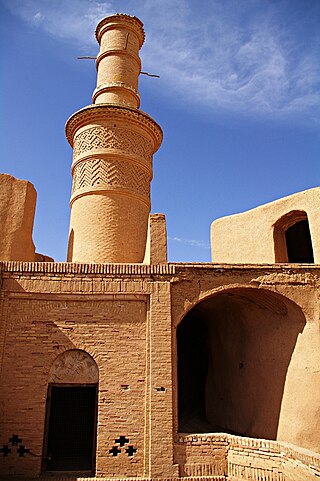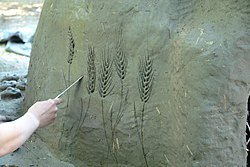
Adobe is a building material made from earth and organic materials. Adobe is Spanish for mudbrick. In some English-speaking regions of Spanish heritage, such as the Southwestern United States, the term is used to refer to any kind of earthen construction, or various architectural styles like Pueblo Revival or Territorial Revival. Most adobe buildings are similar in appearance to cob and rammed earth buildings. Adobe is among the earliest building materials, and is used throughout the world.

Straw is an agricultural byproduct consisting of the dry stalks of cereal plants after the grain and chaff have been removed. It makes up about half of the yield by weight of cereal crops such as barley, oats, rice, rye and wheat. It has a number of different uses, including fuel, livestock bedding and fodder, thatching and basket making.

Mudbrick or mud-brick, also known as unfired brick, is an air-dried brick, made of a mixture of mud mixed with a binding material such as rice husks or straw. Mudbricks are known from 9000 BCE.

Mud, short for muddle, is loam, silt or clay mixed with water. It is usually formed after rainfall or near water sources. Ancient mud deposits hardened over geological time to form sedimentary rock such as shale or mudstone. When geological deposits of mud are formed in estuaries, the resultant layers are termed bay muds. Mud has also been used for centuries as a construction resource for mostly houses and also used as a binder. Mud has also been proved to be almost vital to skin as it can reduce signs of ageing, shrinks pores, removes blackheads, clears acne, and leaves skin tighter and glowing. Mud is created by fungi and microbes as they break down rock.

Straw-bale construction is a building method that uses bales of straw as structural elements, building insulation, or both. This construction method is commonly used in natural building or "brown" construction projects. Research has shown that straw-bale construction is a sustainable method for building, from the standpoint of both materials and energy needed for heating and cooling.

Building material is material used for construction. Many naturally occurring substances, such as clay, rocks, sand, wood, and even twigs and leaves, have been used to construct buildings and other structures, like bridges. Apart from naturally occurring materials, many man-made products are in use, some more and some less synthetic. The manufacturing of building materials is an established industry in many countries and the use of these materials is typically segmented into specific specialty trades, such as carpentry, insulation, plumbing, and roofing work. They provide the make-up of habitats and structures including homes.

Rammed earth is a technique for constructing foundations, floors, and walls using compacted natural raw materials such as earth, chalk, lime, or gravel. It is an ancient method that has been revived recently as a sustainable building method.

Cordwood construction is a term used for a natural building method in which short logs are piled crosswise to build a wall, using mortar or cob to permanently secure them. This technique can use local materials at minimal cost.
Earthbag construction is an inexpensive building method using mostly local soil to create structures which are both strong and can be quickly built.

Loam is soil composed mostly of sand, silt, and a smaller amount of clay. By weight, its mineral composition is about 40–40–20% concentration of sand–silt–clay, respectively. These proportions can vary to a degree, however, and result in different types of loam soils: sandy loam, silty loam, clay loam, sandy clay loam, silty clay loam, and loam.

Natural building is the construction of buildings using systems and materials that emphasize sustainability. This in turn implies durability and the use of minimally processed, plentiful or renewable resources, as well as those that, while recycled or salvaged, produce healthy living environments and maintain indoor air quality. Natural building tends to rely on human labor, more than technology. As Michael G. Smith observes, it depends on "local ecology, geology and climate; on the character of the particular building site, and on the needs and personalities of the builders and users."

Wychert or witchert is a natural blend of white chalk and clay which is mixed with straw to make walls and buildings, usually then thatched or topped with red clay tiles. This historic method of building construction is localised to Haddenham and the surrounding local area in Buckinghamshire. One of the largest known wychert structures is Haddenham Methodist Church.

An earth structure is a building or other structure made largely from soil. Since soil is a widely available material, it has been used in construction since prehistoric times. It may be combined with other materials, compressed and/or baked to add strength.

Superadobe is a form of earthbag construction that was developed by Iranian architect Nader Khalili. The technique uses layered long fabric tubes or bags filled with adobe to form a compression structure. The resulting beehive-shaped structures employ corbelled arches, corbelled domes, and vaults to create sturdy single and double-curved shells. It has received growing interest for the past two decades in the natural building and sustainability movements.
Ceramic houses are buildings made of an earth mixture which is high in clay, and fired to become ceramic. The process of building and firing such houses was developed by Iranian architect Nader Khalili in the late 1970s; he named it Geltaftan. "Gel" means "clay" and "taftan" means "firing, baking, and weaving clay" in Persian language. Khalili's research into creating ceramic houses was strongly based on the idea that permanent, water-resistant, and earthquake-resistant houses could be built with the implementation of the four elements: earth and water to build the forms, and fire and air to finish them. His impassioned work led to a few small scale projects in Iran, including the Javadabad Elementary School, and the Ghaled Mofid restoration project. Aside from Khalili's own documented work, there seems to be little widespread research on ceramic houses.
Alternative natural materials are natural materials like rock or adobe that are not as commonly used as materials such as wood or iron. Alternative natural materials have many practical uses in areas such as sustainable architecture and engineering. The main purpose of using such materials is to minimize the negative effects that built environments can have on the planet, while increasing the efficiency and adaptability of the structures.

Wattle and daub is a composite building method used for making walls and buildings, in which a woven lattice of wooden strips called "wattle" is "daubed" with a sticky material usually made of some combination of wet soil, clay, sand, animal dung and straw. Wattle and daub has been used for at least 6,000 years and is still an important construction method in many parts of the world. Many historic buildings include wattle and daub construction.
Lime-ash floors were an economic form of floor construction from the 15th century to the 19th century, for upper floors in parts of England where limestone or chalk were easily available. They were strong, flexible, and offered good heat and sound insulation.

Musgum mud huts or Musgum dwelling units are traditional domestic structures built of mud by the ethnic Musgum people in the Maga sub-division, Mayo-Danay division, Far North Province in Cameroon. Referred to in Munjuk as Tolek, the dwellings are built in a variety of shapes, such as tall domed or conical dwellings or huts, some with a reverse-V shape, and others with geometric designs.
Ianto Evans is a Welsh-American applied ecologist, landscape architect, inventor, writer, social critic, and teacher. He is known for his work building, writing and teaching about natural building, cob and high-efficiency solid-fuel stoves, ovens and heaters.





















